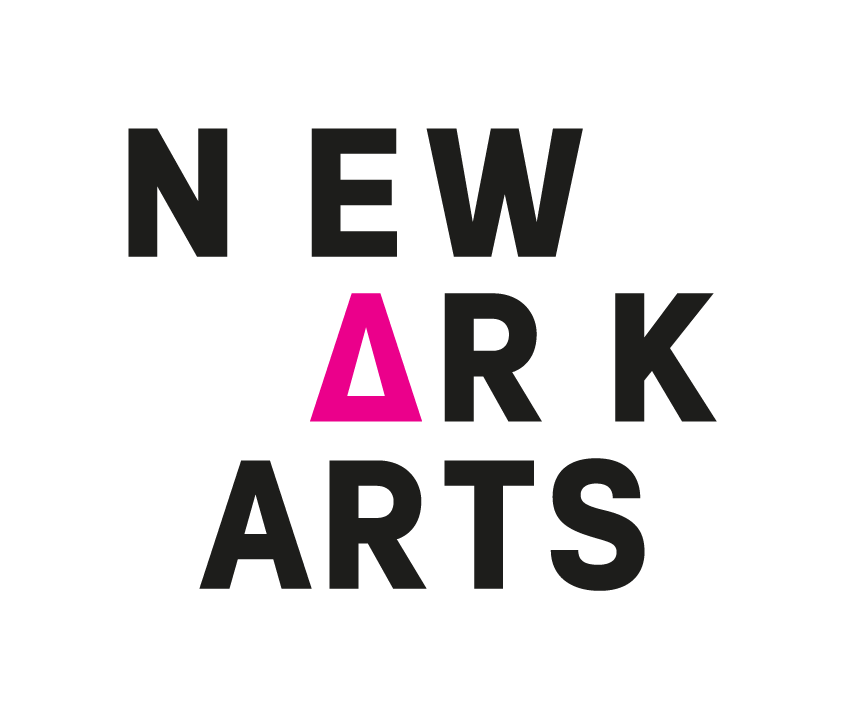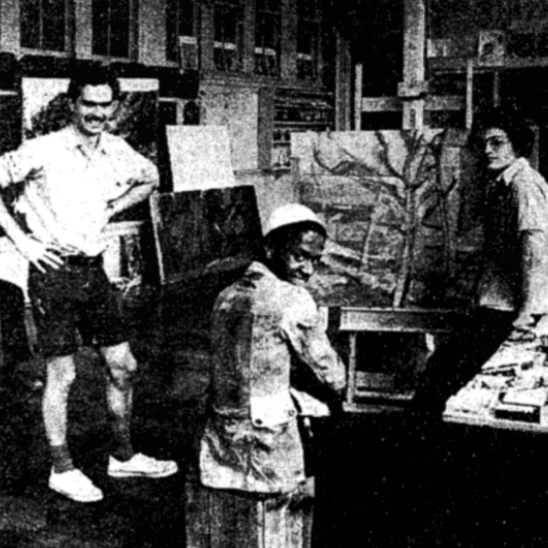MICHAEL A. GONZALES
In the 1970s, Newark was best known for what it used to be. A former factory town that was also once the home of many jazz clubs, culturally the city couldn’t compete with the happenings across the river in New York. Art wise, the Newark Museum, which was established in 1909, was the only major institution in the once bustling metropolis, while the only independently operated space was the AARD Studio Gallery which opened in 1972 and was owned by artist Gladys Grauer. “When I first opened the gallery, there was no art going on in the city,” Grauer told interviewer Gary Campbell in 2017. However, three years later Grauer’s grassroots gallery was no longer alone when City Without Walls (cWOW) opened their doors in 1975.
For the next 42-years, until its closing in late 2017, cWOW was a vital space for emerging artists, students and the Newark community at large. Founded by Thomas Micchelli, Brian Hanlon and Kevin Dowd, who was the first artistic director, the group originally worked out of, as described by a 1976 New York Times article, “a one-time Benedictine convent and an abandoned elementary school operated by the same order at 41 Shipman Street here.” The first year cWOW was in operation, their events included a 53-piece art show in the lobby of the Prudential Life Insurance Company, “A Midsummer Night’s Dream” as part of the Cherry Blossom Festival in Branch Brook Park, as well as painting and drawing workshops, film and theater programs, and travel and art shows that have brought plays, concerts, sculpture and painting to city street corners, schools, parks, and playgrounds.
The gallery moved a few times, with its final home being 6 Crawford Street. The last show, which opened in October, 2017, was a group tribute to Ntozake Shange’s choreopoem “for colored girls who have considered suicide/when the rainbow is enuf.” Mounted during the tenure of cWOW’s last executive director fayemi shakur, the successful show was curated by Peter Wright, a.k.a. Souleo.
“I had visited cWOW a few years before I did the show there and was impressed with the space as well as their mission,” says Souleo, who is currently the Manager of Public Programs at the Newark Museum. “With the for colored girls show, when I began thinking of spaces, I knew I needed a gallery administration that would support the show and shakur got it. cWOW was a hub in the community, and though I knew of the challenges they were facing, which is the challenges that many smaller arts institutions go through, I was still surprised when they closed.”
Having seen the stunning show twice, I thought it was one of the most innovative exhibits I’d seen in years, a sentiment shared with local photographer and HYCIDE publisher Akintola Hanif. “Even though all the artists were not women, it focused on the issues plaguing black women across the country and globe,” Hanif says. “Not only was the art aesthetically superb, it was thoughtful and insightful.” Hanif too has been active in the gallery since 1985 when he participated in a massive graffiti exhibition, curated by Manuel Acevedo, a show that featured some of the best “writers” (artists) from New Jersey as well as from New York City. “There were 10 foot murals, canvases, designer (markers) pieces, airbrushed shirts and abstract pieces from some of the finest graf writers in the tri-state. They made limited edition catalogs with acetate covers that all the writers signed with paint markers. It’s a collector’s item now.”
In addition, Hanif also curated the 2016 photograph exhibit The 5 Wards and worked for years in the ArtReach program, which paired high school students with artistic mentors. In fact, many Newark artists have participated in the mentor program since it began in 1992 under the guidance of Paul Belfanti, a Rhode Island School of Design-trained painter who joined the board in 1986 and served as its chair from 2003-2015, and the late Eleta Caldwell, a board member, artist and principal at Arts High School.
Lifelong Newark resident and artist Jerry Gant also discovered cWOW in the 1980s. “In those years, young black kids in the city didn’t always feel welcome at the Newark Museum,” Gant says. “But, when I discovered cWOW it became my sanctuary. I went there between three and five times a week. At the time the gallery was located on the second floor of the Gateway Center and Roberta was the executive director.” Gant began his career as a graffiti artist, but cites cWOW in helping expand his artistic horizons which today includes a variety of mediums. He has also served as a mentor in the ArtReach program, for five years.
“The ArtReach program is important in the development of young Newark artists who wouldn’t usually have any other outlets for their creativity,” he says. “Part of my mentorship involved taking my mentees to the library, because reading, studying, and research are just as important as the art itself.” In 2005, Gant was given the opportunity to co-curate the show FRESH – A Kaleidoscope of Sound with fayemi shakur.
In 2006 when artist/writer Ben Goldman became the director, he implemented the now popular City Murals program. Two years later artist Malik Whitaker, who moved across the street from cWOW, became quite active in the gallery where he began to volunteer. Working closely with Goldman, he soon became a resident artist, participating in workshops and the mural project. “There was just so much energy at City Without Walls,” Whitaker says. “I liked that it was started by artists and run by artists. The program was funded by the city, but it was the artists and their apprentices that did the work.”
Artists involved included Ibrahim Ahmed III, Steve Green, Sue Daly, and Gladys Grauer. Today known as “the mother of Newark’s African American art community,” she also served on the board at cWOW. It was also during that period, in 2010, that artist Lisa Conrad of the Newark Print Shop was introduced to Rodney Gilbert when she moved to the city.
“Rodney was hugely inspirational to me,” Conrad says. “I met him when I was a student at Rutgers University-Newark and he encouraged me to begin working with cWOW. He took me under his wing and plugged me into cWOW and teaching opportunities.” For four years Conrad was a part of the ArtReach program, teaching various printing processes including screening, etching, dark room and letter processing.” I learned as much from them as much as they did from me. cWOW might’ve been small, but the impact it had on the artists and kids in Newark was big.”
However, as a non-profit entity in a city that has been redeveloping quickly in the last decade, survival wasn’t easy and, unfortunately, the money wasn’t always there. Even as early as 2015 when Malik Whitaker became the interim director, the gallery was on the verge of closing. “We were ready to throw in the towel and the board was already talking about filing for bankruptcy,” he says. “We went from 6 to 8 shows a year down to 4. There wasn’t an official director hired for months, so there was no one applying for grants. It was a mess.”
By the time writer/curator fayemi shakur was hired as the director in 2016, cWOW was already running on empty. Though she tried hard to keep the doors open, it was a battle that couldn’t be won. As reported on the website Brick City Live, “Michelle Sainte, an associate dean at the Icahn School of Medicine at Mount Sinai in New York City who serves as the chair of the organization’s board, praised the gallery’s then-executive director, fayemi shakur, who worked hard last summer to try to forge an alliance with neighborhood groups in Lincoln Park like Symphony Hall and the Lincoln Park Coast Cultural District to stitch together a plan to keep cWOW open. But Sainte said cWOW’s problems began well before shakur started at cWOW in September 2016. It soon became clear that last summer’s efforts to work with the city to come up with a solution didn’t fit into the gallery’s timetable.”
However, while the doors might be closed, hope is still alive. For this year’s Newark Arts Festival, Malik Whitaker put together a cWOW pop-up shop featuring the work of famed photographer T. Eric Monroe and has been actively working to get the doors at Crawford Street reopened. “City Without Walls has meant so much to so many people, I just hope we can reactivate and continue the legacy,” Whitaker says. “The community is booming and we’ve approached the Newark Arts Council to help us in our efforts.”
From City Hall, President and CEO for the Newark Community Economic Development Corporation Aisha Glover says, “For four decades, cWOW was more than just a gallery, it has a played a critical role in the Newark art scene. The gallery also played a key role in community development in the Lincoln Park district. The mayor’s office realizes the importance of City Without Walls and is currently trying to figure out how to resurrect the space into a kind of cWOW 2.0.”

